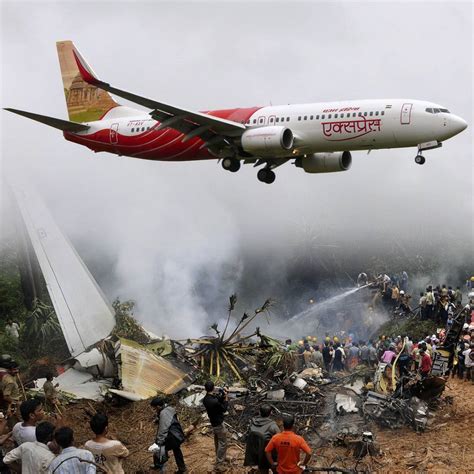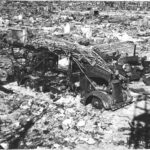
A new theory suggests co-pilot error may have contributed to the fatal Air India Express Flight 812 crash in Mangalore, India, in 2010, which killed 158 people. A recent report, differing from the official investigation that primarily blamed the pilot, points to the co-pilot’s lack of experience and inadequate monitoring of the pilot’s actions during the critical landing phase as potential factors in the disaster.
The Air India Express Flight 812 tragedy, a Boeing 737-800 operating from Dubai to Mangalore, occurred on May 22, 2010, when the aircraft overshot the runway while attempting to land at Mangalore International Airport, plunging into a ravine and resulting in a devastating fire. The crash claimed the lives of 158 of the 166 passengers and crew on board, making it one of the deadliest aviation accidents in India’s history. While the official investigation primarily attributed the crash to pilot error, specifically the captain’s continued approach despite an unstable landing and warnings from the co-pilot, a new perspective is emerging that focuses on the co-pilot’s role and experience level.
According to the new analysis, the co-pilot, though certified, may not have possessed the experience necessary to effectively monitor and challenge the captain’s decisions during the high-pressure landing. “The co-pilot’s lack of experience in monitoring the pilot’s actions is being eyed as a potential factor,” the report states. This perspective challenges the initial narrative that solely placed blame on the captain’s actions. The co-pilot’s responsibility is not just to assist but to actively monitor the flight parameters, challenge deviations from standard operating procedures, and ensure the overall safety of the flight. The report suggests that a more experienced co-pilot might have been able to intervene more decisively, potentially averting the disaster.
The official investigation, conducted by the Court of Inquiry appointed by the Indian government, had concluded that the pilot, Captain Z. Y. Glusica, continued an unstabilized approach despite repeated warnings from the co-pilot, H. S. Ahluwalia, and disregarded standard operating procedures. The investigation also highlighted the captain’s sleep deprivation, which may have impaired his judgment. However, the new report does not dismiss the pilot’s errors but argues that a more proactive co-pilot could have mitigated the risks posed by the captain’s actions.
The focus on the co-pilot’s potential role is not intended to shift blame entirely but to provide a more nuanced understanding of the factors that contributed to the crash. Aviation safety experts emphasize the importance of effective crew resource management (CRM), which involves all members of the flight crew working together to ensure a safe flight. CRM includes clear communication, mutual respect, and the willingness to challenge authority when necessary. In this context, the new report suggests that the co-pilot’s inexperience might have hindered effective CRM, leading to a failure to prevent the captain’s errors from escalating into a catastrophic event.
The incident underscores the critical role of co-pilots in ensuring flight safety. They are not merely assistants but crucial members of the flight crew responsible for monitoring the aircraft’s systems, communicating with air traffic control, and most importantly, backing up the captain. They need to be assertive and confident enough to point out mistakes or deviations from standard procedures, even if it means challenging the authority of a more senior pilot. The Air India Express crash highlights the need for airlines to prioritize the training and experience of co-pilots, ensuring they are equipped to handle the pressures of flight and contribute effectively to crew resource management.
Furthermore, the crash brought to light the challenges associated with landing at Mangalore International Airport, also known as Bajpe Airport. The airport is situated on a hilltop, with steep drops at the end of the runway, making it a challenging airport for pilots, especially during adverse weather conditions. The runway length is also relatively short, requiring precision and accuracy during landings. These factors, combined with potential pilot fatigue and the newly suggested co-pilot’s inexperience, created a perfect storm that led to the tragic accident.
The aftermath of the crash saw significant changes in aviation safety regulations and training procedures in India. Airlines were mandated to enhance pilot training, improve crew resource management, and implement stricter regulations regarding pilot fatigue. The Directorate General of Civil Aviation (DGCA), India’s aviation regulatory body, also increased its oversight of airlines to ensure compliance with safety standards. The Air India Express crash served as a wake-up call for the Indian aviation industry, prompting a renewed focus on safety and the implementation of measures to prevent similar tragedies in the future.
The new report highlighting the co-pilot’s potential role in the crash is likely to spark further debate and analysis within the aviation community. It underscores the complexity of aviation accidents and the importance of considering all possible contributing factors when investigating such events. By examining the co-pilot’s actions and experience level, the report offers a fresh perspective that could lead to further improvements in aviation safety and training. While the official investigation provided valuable insights, this additional analysis emphasizes the continuous need for learning and improvement in the pursuit of safer skies.
The families of the victims of the Air India Express Flight 812 crash have long sought answers and accountability. The new report may offer them a different perspective on the tragedy, potentially leading to a renewed call for further investigation and a more comprehensive understanding of the factors that contributed to the loss of their loved ones. The quest for justice and closure continues as the aviation community reflects on the lessons learned from this devastating event.
The focus on co-pilot error also brings up the subject of command gradient within an aircraft’s cockpit. A steep command gradient means the captain’s authority is rarely, if ever, questioned, even if they are making critical errors. A flatter command gradient means the co-pilot and other crew members are empowered and encouraged to speak up if they see something wrong, regardless of the captain’s seniority. Fostering a flatter command gradient is now a key focus in CRM training globally, and the Air India Express 812 crash serves as a stark reminder of why it is so important. A more assertive and experienced co-pilot, comfortable challenging the captain, might have altered the tragic outcome.
The investigation also prompts discussion on the airline industry’s pilot training programs. Is enough emphasis placed on training co-pilots to not only perform their duties but also to proactively monitor and intervene when necessary? Are co-pilots given the tools and confidence to challenge a captain’s decision without fear of reprisal? These are crucial questions that must be addressed to prevent future accidents. The new report suggests a need for more rigorous training programs that focus on both technical skills and the development of assertiveness and effective communication in the cockpit.
Another critical element is the mental and physical state of the flight crew. The original investigation cited pilot fatigue as a contributing factor. Stricter regulations and monitoring systems are needed to ensure pilots are adequately rested before flights. This includes enforcing rest periods, monitoring sleep patterns, and providing resources for pilots to manage stress and fatigue. The safety of passengers and crew depends on the alertness and judgment of the flight crew, and every effort must be made to ensure they are in optimal condition.
The Air India Express Flight 812 crash also highlights the need for continuous improvement in aircraft technology and safety systems. While pilot error is often a contributing factor in aviation accidents, technological advancements can help mitigate the risks associated with human error. This includes improved flight control systems, enhanced warning systems, and better communication technologies. Investing in research and development of new safety technologies is crucial for preventing future accidents and ensuring the safety of air travel.
In conclusion, while the official investigation into the Air India Express Flight 812 crash primarily blamed pilot error, the new report suggesting co-pilot error as a contributing factor provides a more nuanced perspective on the tragedy. It underscores the importance of effective crew resource management, rigorous pilot training, and continuous improvement in aviation safety standards. The crash serves as a reminder of the complex interplay of factors that can contribute to aviation accidents and the need for a comprehensive approach to safety that addresses all potential risks. The families of the victims deserve a complete understanding of what happened, and the aviation community must learn from this tragedy to prevent similar accidents in the future. The lessons learned from the Air India Express Flight 812 crash will continue to shape aviation safety practices for years to come. The airline industry must prioritize safety above all else, investing in training, technology, and regulatory oversight to ensure the safety of passengers and crew. Only through continuous vigilance and a commitment to safety can we prevent future tragedies and maintain the public’s trust in air travel. The focus now shifts to ensuring the co-pilots are adequately trained, well-supported, and empowered to take appropriate actions during flight operations.
Frequently Asked Questions (FAQ)
1. What caused the Air India Express Flight 812 crash in 2010? The official investigation primarily blamed pilot error, specifically the captain’s decision to continue an unstabilized approach despite warnings from the co-pilot. A new theory suggests that co-pilot error, specifically a lack of experience and inadequate monitoring, may have also contributed to the crash.
2. What is the new theory regarding the co-pilot’s role in the crash? The new theory suggests that the co-pilot’s lack of experience in monitoring the pilot’s actions and intervening when necessary may have been a contributing factor. It highlights the importance of effective crew resource management (CRM) and the need for co-pilots to be assertive and proactive in ensuring flight safety.
3. How does the new report differ from the official investigation’s findings? While the official investigation primarily focused on the pilot’s actions, the new report examines the co-pilot’s role and experience level, suggesting that a more experienced and assertive co-pilot might have been able to prevent the crash by challenging the captain’s decisions.
4. What is Crew Resource Management (CRM), and why is it important? CRM is a system that emphasizes the importance of all members of the flight crew working together to ensure a safe flight. It includes clear communication, mutual respect, and the willingness to challenge authority when necessary. Effective CRM is crucial for preventing errors and ensuring that all potential risks are identified and addressed.
5. What changes were made in aviation safety regulations and training procedures in India after the crash? Following the crash, airlines were mandated to enhance pilot training, improve crew resource management, and implement stricter regulations regarding pilot fatigue. The Directorate General of Civil Aviation (DGCA) also increased its oversight of airlines to ensure compliance with safety standards.
6. What role did Mangalore International Airport play in the accident?
Mangalore International Airport, also known as Bajpe Airport, is situated on a hilltop, with steep drops at the end of the runway, making it a challenging airport for pilots, especially during adverse weather conditions. The runway length is also relatively short, requiring precision and accuracy during landings. The combination of these factors increases the complexity of landing and taking off at the airport, placing additional demands on the flight crew.
7. What is command gradient, and how does it relate to the Air India Express 812 crash?
Command gradient refers to the level of authority and the willingness of junior crew members to challenge the decisions of senior crew members, particularly the captain. A steep command gradient means the captain’s authority is rarely questioned, even if they are making errors. A flatter command gradient means the co-pilot and other crew members are empowered and encouraged to speak up if they see something wrong. The Air India Express 812 crash highlights the importance of a flatter command gradient, as a more assertive and experienced co-pilot might have altered the tragic outcome.
8. What are some areas for improvement in pilot training programs that were highlighted by the crash?
The crash suggests a need for more rigorous training programs that focus on both technical skills and the development of assertiveness and effective communication in the cockpit. Co-pilots need to be trained to proactively monitor and intervene when necessary, and they should be given the tools and confidence to challenge a captain’s decision without fear of reprisal. Additionally, training programs should emphasize crew resource management (CRM) and the importance of open communication and mutual respect among crew members.
9. How does pilot fatigue contribute to aviation accidents, and what measures can be taken to mitigate it?
Pilot fatigue can impair judgment, reduce alertness, and increase the likelihood of errors, making it a significant contributing factor in aviation accidents. Stricter regulations and monitoring systems are needed to ensure pilots are adequately rested before flights. This includes enforcing rest periods, monitoring sleep patterns, and providing resources for pilots to manage stress and fatigue. The safety of passengers and crew depends on the alertness and judgment of the flight crew, and every effort must be made to ensure they are in optimal condition.
10. What advancements in aircraft technology and safety systems can help prevent future accidents?
While pilot error is often a contributing factor in aviation accidents, technological advancements can help mitigate the risks associated with human error. This includes improved flight control systems, enhanced warning systems, and better communication technologies. Investing in research and development of new safety technologies is crucial for preventing future accidents and ensuring the safety of air travel. Examples include enhanced ground proximity warning systems (EGPWS), traffic collision avoidance systems (TCAS), and advanced autopilot systems.
11. What is the role of the Directorate General of Civil Aviation (DGCA) in ensuring aviation safety in India?
The Directorate General of Civil Aviation (DGCA) is India’s aviation regulatory body, responsible for overseeing and enforcing aviation safety standards. The DGCA’s role includes conducting inspections of airlines, certifying pilots and aircraft, and investigating aviation accidents. Following the Air India Express Flight 812 crash, the DGCA increased its oversight of airlines to ensure compliance with safety standards and implemented new regulations aimed at improving pilot training, crew resource management, and pilot fatigue management.
12. How can airlines foster a culture of safety and encourage open communication among flight crew members?
Airlines can foster a culture of safety by prioritizing safety above all else and encouraging open communication among flight crew members. This includes providing training on crew resource management (CRM), creating a non-punitive environment where crew members feel comfortable reporting errors or concerns, and empowering junior crew members to challenge the decisions of senior crew members when necessary. Regular safety meetings and audits can also help to identify and address potential safety risks.
13. What are some of the challenges associated with landing at airports located in difficult terrain, such as Mangalore International Airport?
Airports located in difficult terrain, such as Mangalore International Airport, often present unique challenges for pilots. These challenges may include short runways, steep approaches, obstacles in the flight path, and adverse weather conditions. Pilots need to be highly skilled and experienced to safely navigate these airports, and they must be aware of the potential risks and hazards associated with landing and taking off. Regular training and simulations can help pilots to prepare for these challenges.
14. What support is available for the families of victims of aviation accidents?
Following an aviation accident, airlines and government agencies typically provide support to the families of victims. This support may include financial assistance, grief counseling, and assistance with travel arrangements. In addition, victim support organizations can provide ongoing support and resources to help families cope with their loss. The families of the victims of the Air India Express Flight 812 crash have long sought answers and accountability, and it’s crucial that they receive the support they need to navigate the aftermath of the tragedy.
15. How can lessons learned from aviation accidents be used to improve safety in the future?
Aviation accidents are thoroughly investigated to identify the causes and contributing factors. The lessons learned from these investigations are then used to improve safety standards, training procedures, and aircraft technology. This information is shared with airlines, regulatory agencies, and other stakeholders in the aviation industry to prevent similar accidents from happening in the future. Continuous learning and improvement are essential for maintaining a high level of safety in air travel.









